
Verticordia huegelii, commonly known as variegated featherflower, is a flowering plant in the myrtle family, Myrtaceae and is endemic to the south-west of Western Australia. It is a sometimes an erect shrub, sometimes sprawling to almost prostrate. It has linear leaves and very feathery flowers in spring. The flowers are usually cream-coloured or white, becoming pinkish and reddish or maroon as the flowers age, giving a variegated appearance to the display.
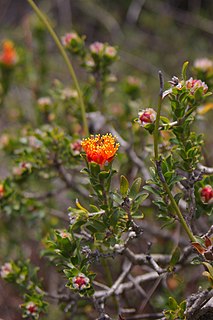
Eremaea is a genus of woody shrubs and small trees in the family Myrtaceae and is endemic to the south-west of Western Australia. Little study of the genus as a whole had been undertaken until Roger Hnatiuk researched Eremaea and published a paper in 1993, A revision of the genus Eremaea (Myrtaceae) in Nuytsia. The first species to be described was Eremaea pauciflora in 1837 and by 1964, the number of species known had increased to 12. Hnatiuk recognised 16 species, 5 subspecies and a number of varieties.

Eremaea fimbriata is a plant in the myrtle family, Myrtaceae and is endemic to the south-west of Western Australia. It is a small shrub with small leaves and single purple flowers on the ends of the branches. The fruits are woody, urn-shaped with a small opening at the top. Unlike other eremaeas which remain dormant during winter, Eremaea fimbriata begins the new year's growth in July or August.

Eremaea acutifolia, commonly known as rusty eremaea is a plant in the myrtle family, Myrtaceae and is endemic to the south-west of Western Australia. It is a small shrub with needle-like leaves and which bears orange-coloured flowers on short side branches and fruits with a surface that is rough to the touch.

Eremaea asterocarpa is a plant in the myrtle family, Myrtaceae and is endemic to the south-west of Western Australia. It is a shrub with broad, flat leaves, and orange-coloured flowers in late winter or spring. Single flowers appear on the ends of branches formed the previous year.
Eremaea atala is a plant in the myrtle family, Myrtaceae and is endemic to the south-west of Western Australia. It is a small shrub with small, soft, non-prickly leaves, and purple flowers in late spring or summer. Flowers appear in groups of up to five usually on the ends of branches formed in the same year's growth.
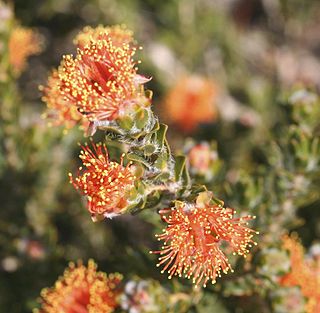
Eremaea beaufortioides is a plant in the myrtle family, Myrtaceae and is endemic to the south-west of Western Australia. It is a spreading shrub with oval to egg-shaped leaves, and orange flowers in spring. Flowers appear in groups of one to six on the ends of long branches formed in the previous year.
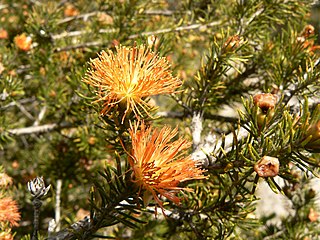
Eremaea blackwelliana is a plant in the myrtle family, Myrtaceae and is endemic to the south-west of Western Australia. It is a shrub with soft, pointed, non-prickly leaves, orange flowers in spring and cup shaped to almost spherical woody fruits. Flowers appear singly on the ends of short side branches formed in the previous year.

Eremaea brevifolia is a plant in the myrtle family, Myrtaceae and is endemic to the south-west of Western Australia. It is an erect, compact to spreading shrub with small, crowded leaves and orange-coloured flowers in early spring, followed by fruits with a rough outer surface.
Eremaea × codonocarpa is a plant in the myrtle family, Myrtaceae and is endemic to the south-west of Western Australia. It is thought to be a stabilised hybrid between two subspecies of Eremaea. It is a small shrub with triangular leaves and flowers a shade of pink to purple on the ends of the branches.
Eremaea dendroidea is a plant in the myrtle family, Myrtaceae and is endemic to the south-west of Western Australia. It is a small tree with small leaves and orange-coloured flowers on the ends of the branches in September. It has the most northerly distribution of all the eremaeas.
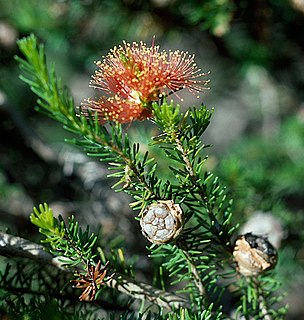
Eremaea ebracteata is a plant in the myrtle family, Myrtaceae and is endemic to the south-west of Western Australia. It is a shrub with narrow, mostly linear leaves and which bears orange-coloured flowers on the long branches of the same season's growth. The fruits have a surface that is rough and lumpy.

Eremaea ectadioclada is a plant in the myrtle family, Myrtaceae and is endemic to the south-west of Western Australia. It is a low, spreading shrub with small leaves, and orange-coloured flowers on the ends of the long branches which grew in the previous year.
Eremaea hadra is a plant in the myrtle family, Myrtaceae and is endemic to the south-west of Western Australia. It is a shrub with thin, flat and very prickly leaves. It has violet-coloured flowers on the ends of its branches in late spring followed by smooth, cup-shaped fruits.
Eremaea × phoenicea is a plant in the myrtle family, Myrtaceae and is endemic to the south-west of Western Australia. It is thought to be a stabilised hybrid between two subspecies of Eremaea. It is an erect to spreading shrub with pointed, elliptic leaves and small groups of flowers, a shade of pink to red, on the ends of the branches.
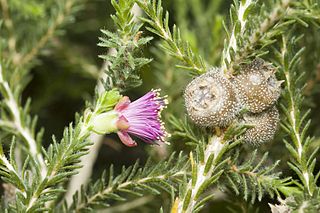
Eremaea purpurea is a plant in the myrtle family, Myrtaceae and is endemic to the south-west of Western Australia. It is a shrub with erect branches, small leaves and purple flowers in pairs on the ends of the branches. The fruits are woody, cup-shaped capsules which release their seeds when dry.

Eremaea violacea is a plant in the myrtle family, Myrtaceae and is endemic to the south-west of Western Australia. It is low, spreading shrub with narrow, prickly leaves and which bears violet-coloured flowers on short side branches.
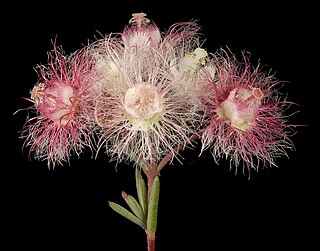
Verticordia huegelii var. huegelii, commonly known as variegated featherflower, is a flowering plant in the myrtle family, Myrtaceae and is endemic to the south-west of Western Australia. It is an upright, slender or bushy shrub, with creamish-white flowers turning pink or reddish maroon as they age, giving the plant a variegated appearance. It is similar to Verticordia huegelii var. decumbens but is more upright than that variety and lacks a lignotuber.

Verticordia huegelii var. decumbens, commonly known as variegated featherflower, is a flowering plant in the myrtle family, Myrtaceae and is endemic to the south-west of Western Australia. It is an almost prostrate shrub, with creamish-lemon coloured flowers turning pink then red as they age, giving the plant a variegated appearance. It is similar to Verticordia huegelii var. huegelii but has a lignotuber and a lower growth habit.

Corymbia eremaea, commonly known as mallee bloodwood, hill bloodwood and centre range bloodwood, is a small, mallee-like tree that is endemic to central Australia. Indigenous Australians know the plant as muur-muurpa. It has rough, evenly tessellated bark, lance-shaped leaves, oval to pear-shaped flower buds arranged on a branching peduncle and urn-shaped fruit.
















